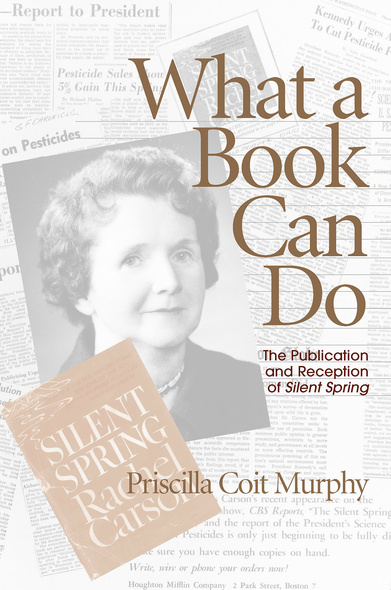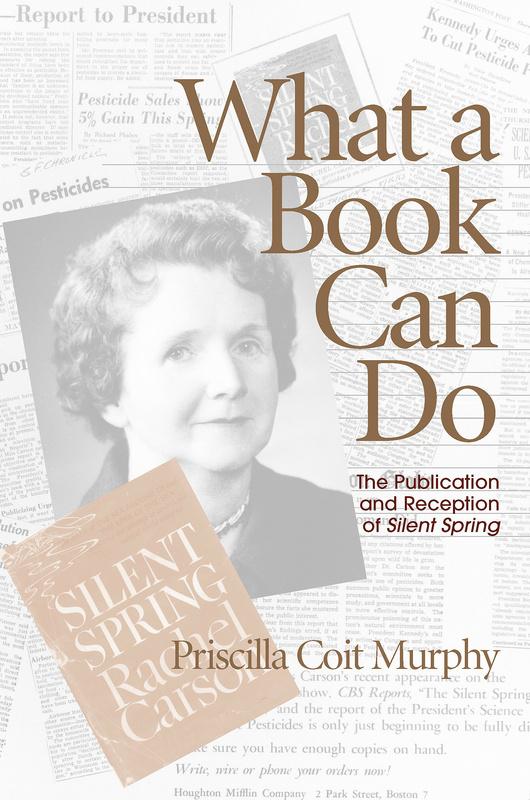What a Book Can Do
The Publication and Reception of "Silent Spring"
University of Massachusetts Press
In 1962 the publication of Rachel Carson's Silent Spring sparked widespread public debate on the issue of pesticide abuse and environmental degradation. The discussion permeated the entire print and electronic media system of mid-twentieth century America. Although Carson's text was serialized in the New Yorker, it made a significant difference that it was also published as a book. With clarity and precision, Priscilla Coit Murphy explores the importance of the book form for the author, her editors and publishers, her detractors, the media, and the public at large.
Murphy reviews the publishing history of the Houghton Mifflin edition and the prior New Yorker serialization, describing Carson's approach to her project as well as the views and expectations of her editors. She also documents the response of opponents to Carson's message, notably the powerful chemical industry, including efforts to undermine, delay, or stop publication altogether.
Murphy then investigates the media's role, showing that it went well beyond providing a forum for debate. In addition, she analyzes the perceptions and expectations of the public at large regarding the book, the debate, and the media. By probing all of these perspectives, Murphy sheds new light on the dynamic between newsmaking books, the media, and the public. In the process, she addresses a host of broader questions about the place of books in American culture, past, present, and future.
Murphy reviews the publishing history of the Houghton Mifflin edition and the prior New Yorker serialization, describing Carson's approach to her project as well as the views and expectations of her editors. She also documents the response of opponents to Carson's message, notably the powerful chemical industry, including efforts to undermine, delay, or stop publication altogether.
Murphy then investigates the media's role, showing that it went well beyond providing a forum for debate. In addition, she analyzes the perceptions and expectations of the public at large regarding the book, the debate, and the media. By probing all of these perspectives, Murphy sheds new light on the dynamic between newsmaking books, the media, and the public. In the process, she addresses a host of broader questions about the place of books in American culture, past, present, and future.
A highly readable and often illuminating history of the writing and aftermath of Rachel Carson's masterpiece affirms the unique place of the book as an agent of change, and raises timely questions about science, the media, and the right to know.'—Orion Magazine
'Silent Spring's author intended its information to be useful not only to ordinary people but also to those in authority. . . . The author is to be commended for producing such a thoroughly readable, enjoyable and scholarly work.'—Rachel Carson Council
'This book would make for an ideal reading choice for any public relations case study or basic reporting class. . . . Murphy's analysis of Carson's work and how the public reacted provides great insight into the power of well-researched and well-written journalism in book form.''—The Carolina Communicator
'In this in-depth study of a best-selling and influential book, Murphy makes an extremely important contribution to the history of print culture. . . . Her book is a quick read and not at all ponderous, so I recommend it not only to scholars in book history and mass communications, but also to anyone interested in the influence of the media and in Silent Spring itself. It will be a marvelous addition to mass communications and book history classes.'—Beth Luey, author of Handbook for Academic Authors
'Combines a marvelous blend of good detective work and rounding up of the correct suspects. There is, to my mind, a novel combination of literatures (publishing history, media effects, social movement research) that tells a very compelling story. Murphy recreates the time period nicely and captures the relationship between Carson and The New Yorker and her Houghton Mifflin editor beautifully. . . . I can think of very few comparable studies of a work of nonfiction.'—Walter W. Powell, coauthor of Books: The Culture and Commerce of Publishing
'As a very good writter telling a familiar yet mostly unknown story, she presents detailed and thorough research, and her analysis and arguements are convincing. She brings a mass-media-studies perspective to the book in society that is quite surprising to scholars who are used to starting with the book and looking forward.'—Papers of the Bibiographical Society of Canada
'In 1962 the appearance of naturalist Rachel Carson's Silent Spring not only sparked debate on pesticide and ecology issues; it helped change the nature and effectiveness of preservation efforts around the world. It first appeared as a magazine serialization, but its book version really reached out to larger audiences. Priscilla Coit Murphy's What A Book Can Do: The Publication And Reception Of Silent Spring isn't just another analysis of the book itself: it's a review of the publishing history of the Houghton Mifflion edition and the prior New Yorker serialization, incorporating the views of her editors as well as Carson herself--and her opponents. An exceptional history which is strongly recommended for any reader of Silent Spring.'—Midwest Book Review
'Monaghan's meticulous research, strong theoretical organization, and persuasive case studies provide evidence for the modernists' thesis.'—The Historian
'Discusses the entire process of envisioning, researching, writing, publishing, marketing, distributing, disseminating, and defending Rachel Carson's 'Silent Spring'. . . . Murphy's interesting, well-written account goes behind the many pro- and anti-Carson myths to help explain how 'Silent Spring' had its monumental impact as an earth-shaking, movement-spawning book. . . . Murphy's treatment of a topic that still engenders passion and anger is commendably evenhanded.'—Register of the Kentucky Historical Society
Priscilla Coit Murphy is an independent scholar who lives in Chapel Hill, North Carolina.





